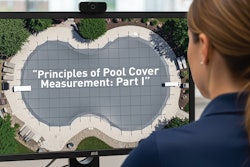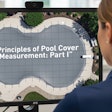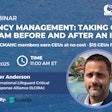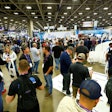Outbreaks of waterborne illnesses — in particular, those caused by chloramine formation in pools — continue to cause concern. As a result, public interest in alternative sanitizers like ozone and UV has increased. Builder and water-quality advocate Steve Kenny recently decided to up the water-quality ante with a mobile demonstration system that is ready to take to the highway in pursuit of improved water quality in both residential and commercial pools.
It's amazing the lengths people will go to prove a point, especially when they firmly believe doing so will benefit others as well as themselves. Builder and self-made chemistry expert Steve Kenny, president of SRK Pools on Long Island, stands as a prime example of what can happen when belief meets action.
Kenny is an unapologetic crusader for water quality in both residential and commercial pools. In that pursuit, he has developed his own brand of treatment system called HydroZone 3, a combination of ozone, UV and small amounts of chlorine. Case studies and testing have proven the capabilities of the system, but mainstream uptake has been slow.
"This is something I truly believe in. I know it works," he says. "The problem has been that no matter how hard I've tried, it's been tough convincing people and even more difficult to persuade them to invest in the technology.
"It came to the point where I'd build a pool and offer to install the system for free and if the clients liked it after a month they could keep it. If they didn't we'd install something else. Every time we did that, they loved the system and were more than happy to pay for it."
Despite numerous glowing testimonials from private pool owners and commercial operators alike — along with extensive test results from independent laboratories — the struggle for acceptance has been a decidedly uphill battle.
So Kenny has decided to make his case in stronger terms.
Last year he began work on a trailer-mounted version of his treatment system to be used for on-site demonstrations.
"I needed to generate an 'a-ha' moment," he says. "The best way I figured to do so would be to take the system into the field and prove it in real time, right there in their own pools. When they see the dramatic difference, then they'll be able to understand what I'm talking about."
Kenny finished the mobile system early this year, a project with, all-told, a $160,000 price tag. Although a significant investment of both time and money, he is convinced the as-yet-unnamed rig will eventually pay for itself. "While I'm obviously concerned with the return on investment, my greater hope is that people will see that they can dramatically improve water quality and better protect the health of those using their pools."
Although an idealist at heart, Kenny is also pragmatic. In addition to the system's efficacy, he further believes timing is working in his favor.
"Problems associated with poor water quality are affecting people's lives," he says. "Cryptosporidium outbreaks, asthma and other respiratory problems due to poor air quality associated with indoor pools, skin irritations and red, burning eyes and a number of other issues are all directly related to poor water quality. Based on what I'm seeing right now, people are becoming far more concerned, and rightfully so."
INCREASED ATTENTION
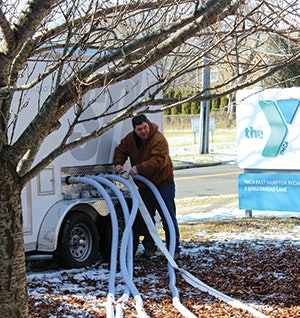 Click to enlarge
Click to enlarge
In addition to the immediate health concerns among consumers, the U.S. government is also playing a significant role in the quest for improved water quality. Part of that campaign involves recommendations for using Kenny's chosen technologies, ozone and UV, to combat water quality issues.
Last summer, the U.S. Centers For Disease Control released the Model Aquatic Health Code, a document created to define key management and service issues for commercial swimming pools, spas, interactive features and wading pools.
The MAHC establishes recommended standards for a comprehensive set of safety and health-related measures, water quality chief among them. In the MAHC abstract, its authors write, "Secondary disinfection [is] required for 'increased risk' aquatic venues such as interactive features, spray pads, wading pools, and other venues designed primarily for diaper-aged children as well as therapy pools."
That recommendation stands as the U.S. government's most specific and potent response to outbreaks of waterborne diseases in pools and waterparks, as well as poor water quality conditions, the latter largely due to the build up of chloramines and other sanitation byproducts.
"The MAHC recommends additional secondary disinfection safeguards such as ultraviolet light or ozone, which kills crypto, particularly for increased-risk aquatic venues like children's wading pools," the document states.
In effect, treatment technologies once considered "alternative sanitizers," i.e. ozone and UV, have now become codified in one of, if not the, most important set of aquatic industry guidelines available in the United States. Proper filtration and chlorination remain central aspects in the overall scope of water treatment, but those measures now have company in the form of UV and ozone.
A year later, water quality remains a hot topic. According to a June 26 "CBS This Morning" report about increases in pool-related illness, Dr. Holly Phillips cited a CDC report that from 2011 to 2012, the most recent available data, there were 1,748 documented cases of waterborne illness, 77 percent of which occurred in the treated waters of pools, spas and waterparks, 54 percent due to crypto.
"Chlorine does not kill cryptosporidium," Phillips noted, and further explained that other common maladies including odor, red eyes and respiratory problems such as persistent coughing are caused by "a chemical reaction between chorine and dirt, sweat and urine."
MILES AHEAD
Kenny is among a growing number of the industry's "chemically inclined" members who are in lockstep with the CDC in turning to ozone and/or UV technology, both of which are far more common in pools than they were even just a few years ago.
His own combination of the two is the direct result of years of personal research and testing. "It really started back in 2008 with my own kids and the local indoor pool," he recalls. "They loved swimming there, but when they'd come home they'd be sick. My son especially was having some major problems breathing. It was terrible."
It didn't take long before Kenny came to believe there was a relationship between the unpleasant air and water quality at the local indoor facility and ailments suffered by its regular users. "We weren't the only family having problems with kids getting sick after using the pool," he says. "When we'd go in there, I'd never seen so many asthma inhalers all over the deck."
Out of both parental and professional concern, Kenny began lobbying managers at the facility to upgrade their system to UV and ozone with chlorine playing a supporting role as an added measure preventing bather-to-bather infection.
"That was when I first got a taste of how hard it would be to convince people," he recalls. "For years the board of directors had no interest, despite the problems they were experiencing. They simply thought that chlorine treatment was doing the job well enough and there was no need to change."
As time moved on, Kenny has developed an impressive set of glowingly satisfied clients who are using his system. He also conducted multiple tests, by himself and by independent laboratories, all of which have confirmed the system's performance.
BYPASS ON WHEELS
 Steve Kenny's mobile-treatment system functions as a by-pass loop on wheels. Because there's more to quality water than meets the eyes and nose, he backs up results with independent before-and-after testing. - Click to enlarge
Steve Kenny's mobile-treatment system functions as a by-pass loop on wheels. Because there's more to quality water than meets the eyes and nose, he backs up results with independent before-and-after testing. - Click to enlarge
The trailer-mounted apparatus consists of two separate units, one for large bodies of water and another for vessels with comparatively small volume. The system uses the facility's filtration and chlorine/pH feed equipment, acting as a side stream to the pool's existing sanitization, adding UV and ozone treatment. Kenny selected ETS UV systems and Del Ozone, manufacturers he feels make reliable products but also provide "excellent technical support."
The setup also includes pumps, digital control and multiple exterior hose connections. Kenny also developed special return manifolds used to distribute and mix the treated water. The systems do not include filtration.
In effect, the trailer acts as a temporary treatment bypass, much the way a permanently installed system would continually treat a specific percentage of the circulation. "It's really straightforward," he says. "You drive to the site and set it up as close to the water as you can and then run the system for anywhere from 12 hours to three days or more, depending on the size of the pool and some other variables. Then you sit back and let the results speak for themselves."
Although he reports the difference is often easily seen and felt by way of water clarity, lack of smell and bather cleanliness after swimming in the treated pool, Kenny backs up those impressions with before-and-after pathogen testing, again by an independent lab. The results uniformly indicate virtually complete eradication of the harmful pathogens.
"Much of why the combination of ozone and UV works so well is because together they generate an effect known as AOP, or advanced oxidation process," he explains. "The chemistry is complex, but basically, AOP is the result of combining UV and ozone. It creates the hydroxyl radical, which is an extremely short-lived but extraordinarily powerful oxidizer."
TOLD THEM SO
This year, Kenny's long journey with the local indoor facility came full circle when they invited him to demonstrate the system. Initially, Kenny was given only 18 hours to treat the facility's 140,000 gallons. "Even in that limited time frame, there was a remarkable improvement. We documented the whole thing and even interviewed some of the swimmers and facility staff," he explains. "And we were able to document that microsporidia was present before the treatment and then gone after the treatment."
(Indeed, after finishing the interview for this story, Kenny flooded the author's email inbox with numerous video accounts from swimmers who all eagerly raved about the improved water quality and how clean they felt after using the pool.)
In April, Kenny learned the pool was going to be closed for draining, which they do four times a year as recommended by the local health department. He urged the facility's board of directors to let him run the system, but this time for five days. "I asked them to give me the time that they planned to be closed for this practice of draining and refilling to show them how this system will prevent this exercise," he says.
Although they only gave him three days, once again, the system exceeded expectations. As a result, the pool did not need draining.
"That saved the water, chemicals needed for start up, down time and the cost of reheating the pool," he recalls. "After all those years of frustration trying to convince them to even consider the technology, it was really satisfying to finally have the opportunity to prove it once and for all.
"We're really just getting started with the mobile system," he says. "I'm confident moving ahead. The more people learn what can be accomplished in terms of great water quality, the sooner we'll see overall conditions improve and far fewer people will wind up sick.
"And that," he concludes, "is why I decided to take the system on the road. It's human nature: Seeing is believing."
Giving UV a Try
Not every pool builder or service pro has the ability to create a mobile sanitation system like SRK Pools. However, many pool builders and service pros use simpler demonstration methods. For example, Delta UV Ultraviolet Solutions in Gardena, Calif., has established a program called "Try-Me." A simple concept, UV Delta's Sales and Marketing Manager, Jeff Boynton explains, "It's a unit that is installed at the homeowner's pool for 30 days to demonstrate the benefits of UV." Boynton says the program was developed because Delta UV's most successful dealers have proven the demonstration method works. "The customer can see and feel the difference — and as they say, seeing is believing. Ultimately the customer keeps the UV water treatment system," Boynton says. "Having one pool owner willing to let you bring other potential customers to their backyard can also be an effective way to sell the UV units, especially if the current UV pool owner is willing to testify its benefits to a potential customer." |
Beyond PoolsAlthough the mobile system described in the adjacent text was built with pool treatment in mind, Steve Kenny has also used it in a vastly different setting. "We used it to show a fish-packing company how they could treat contaminated water," he recalls. The company, which operates multiple facilities on Long Island, had to close its largest plant due to contaminated well water it used in the packing process. Rather than the bacteria and chloramines found in swimming pools, the problem was due to a variety of harmful organic compounds. "The plant had been closed for two years," he recalls. "And no one had any idea of how to deal with the well water problem. For that company, it was an extremely serious situation." Rather than test water directly inside the well, Kenny filled a portable cistern with 300 gallons then let the ozone and UV work their magic. "I had never considered this kind of demonstration before so I was eager to find out what might happen in that kind of situation." The result: the water in the cistern was returned to drinking water standards. |
Comments or thoughts on this article? Please e-mail [email protected].






























